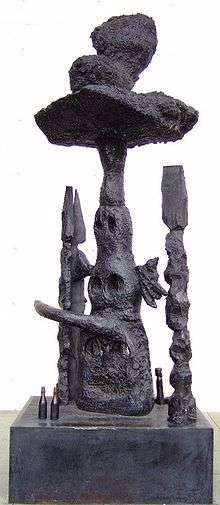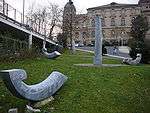A. R. Penck
| A. R. Penck | |
|---|---|
 Future of the soldiers (1995) by A. R. Penck | |
| Born |
Ralf Winkler 5 October 1939 Dresden |
| Died |
2 May 2017 (aged 77)[1] Zürich |
| Nationality | German |
| Known for | Painting, Printmaking, Sculpture, Free jazz |
Ralf Winkler, alias A. R. Penck, Mike Hammer, T. M., Mickey Spilane, Theodor Marx, "a. Y." or just "Y" (5 October 1939 – 2 May 2017[1]) was a German painter, printmaker, sculptor, and jazz drummer.[2]
Life and career
Penck was born in Dresden, Germany. In his early teens he took painting and drawing lessons with Jürgen Böttcher, known by the pseudonym Strawalde, and joined with him to form the renegade artists’ group Erste Phalanx Nedserd (“Dresden” spelled backward). He later worked for a year as a trainee draftsman at the state advertising agency in Dresden. After failing to gain admission to the fine-arts academies in Dresden and East Berlin, Penck worked for several years as a stoker, a newspaper deliverer, a margarine packer and a night watchman.[3]
Penck later studied together with a group of other neo-expressionist painters in Dresden. He became one of the foremost exponents of the new figuration alongside Jörg Immendorff, Georg Baselitz and Markus Lüpertz. Under the East German communist regime, they were watched by the secret police and were considered dissidents. In the late 1970s they were included in shows in West Berlin and were seen as exponents of free speech in the East. Their work was shown by major museums and galleries in the West throughout the 1980s. They were included in a number of important shows including the famous Zeitgeist exhibition in the well-known Martin Gropius Bau museum and the important New Art show at the Tate in 1983.
Penck first attracted attention with a series of paintings and sculptures, made in the 1960s and early 1970s, that he called Standarts, a conflation of "standard" and "art", with an echo of the German word for banner or flag, Standarte.[3] In the 1980s he became known worldwide for paintings with pictographic, neo-primitivist imagery of human figures and other totemic forms. He was included in many important shows both in London and New York City.
Penck's sculptures, though less familiar, evoke the same primitive themes as his paintings and drawings. They use common everyday materials such as wood, bottles, cardboard boxes, tin cans, masking tape, tinfoil, and wire, and are crudely painted and assembled. Despite their anti-art aesthetic and the rough-and-ready quality of their construction, they have the same symbolic, archetypal anthropomorphic forms as his flat symbolic paintings. The paintings are influenced by Paul Klee's work and mix the flatness of Egyptian or Mayan writing with the crudity of the late black paintings by Jackson Pollock. The sculptures are often reminiscent of the stone heads of Easter Island and other Oceanic art.
A keen drummer, he was a member and with Frank Wollny co-founder of the free jazz group Triple Trip Touch (aka T.T.T. or TTT) and took every opportunity to play with some of the best Jazz musicians of the late 1980s including Butch Morris, Frank Wright, Billy Bang, Louis Moholo and Frank Lowe, organising events at his country mansion in Heimbach in 1990 involving installations by Lennie Lee, performances by Anna Homler and paintings by Christine Kuhn.
After leaving East Germany, Penck settled in Kerpen, southwest of Cologne, but in 1983 he moved to London. He later relocated to Dublin.[3] At the time of his death, Penck lived and worked in Berlin, Düsseldorf, Dublin and New York City.
Penck died on 2 May 2017 in Zürich at the age of 77.
Works in public collections

- Kunstsammlung Deutsche Bundesbank, Frankfurt am Main
- Migros Museum für Gegenwartskunst, Zürich
- Museum Küppersmühle für Moderne Kunst, Duisburg
- Kunstmuseum Walter, Augsburg
- Museum of Modern Art, New York
- Hamburger Kunsthalle, Hamburg
- Städelsches Kunstinstitut, Frankfurt am Main
- Stedelijk Museum, Amsterdam
- Städtische Galerie Dresden (Collection Jürgen Schweinebraden)
- Musée d’Art Moderne et Contemporain de Strasbourg, Strassburg
- Galerie Neue Meister, Dresden
Further reading
- Ingrid Pfeiffer, A. R. Penck, Isabelle Graw, Harald Kunde, Kewin Power, Pirkko Rathgeber, Jürgen Schweinebraden: A. R. Penck: Works 1961–2001 German/English. Düsseldorf: Richter-Verlag, 2007, ISBN 978-3-937572-68-0.
- Exhibition catalog: documenta 5. Befragung der Realität – Bildwelten heute; Volume 1: (Material); Volume 2: (Exponatliste); Kassel 1972
- documenta archive (ed); Wiedervorlage d5 – Eine Befragung des Archivs zur documenta 1972; Kassel/Ostfildern 2001, ISBN 3-7757-1121-X
- documenta 6 catalog: Volume 1: Malerei, Plastik/Environment, Performance; Volume 2: Fotografie, Film, Video; Volume 3: Handzeichnungen, Utopisches Design, Bücher; Kassel 1977. ISBN 3-920453-00-X
- documenta 7 Kassel catalog; Volume 1: (Visuelle Biographien der Künstler); Volume 2: (Aktuelle Arbeiten der Künstler); Kassel 1982. ISBN 3-920453-02-6
- Documenta IX: Kassel, 13. June-20. September 1992 – Catalog in three volumes; Stuttgart 1992, ISBN 3-89322-380-0 (German) / ISBN 3-89322-381-9 (English)
- Anke Scharnhorst: Penck, A. R.[4] In: Wer war wer in der DDR?. 5. Ausgabe. Band 2, Ch. Links Verlag, Berlin 2010, ISBN 978-3-86153-561-4
References
- 1 2 dpa (2017-05-03). "Legendärer Maler A. R. Penck ist tot". Frankfurter Allgemeine Zeitung (FAZ) (in German). Archived from the original on 2017-05-03. Retrieved 2017-05-03.
- ↑ Basciano, Oliver (2017-05-05). "AR Penck obituary". The Guardian. Retrieved 2017-05-07.
- 1 2 3 Grimes, William (2017-05-05), "A. R. Penck, German Neo-Expressionist of Cold-War Era, Dies at 77", New York Times
- ↑ http://bundesstiftung-aufarbeitung.de/wer-war-wer-in-der-ddr-%2363%3B-1424.html?ID=2624
External links
| Wikimedia Commons has media related to A. R. Penck. |
- Discogs: Releases
- Michael Werner Gallery
- Hanel Gallery
- French gallery's site of the artist
- - Artists.org
- - Biography
- - Artnet.com
- - Artcyclopedia
- - Widewalls.ch
- - art / bollinger- features works of A. R. Penck
- - Galerie Michael Schultz features works of A. R. Penck